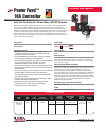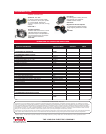
Power Feed 10A Controller
[4]
A CLOSER LOOK
www.lincolnelectric.com
Driving Superior Welding
Performance
Lincoln’s Waveform Control
Technology controls and shapes the
output waveforms (or weld modes)
to adapt to virtually any application,
material or weld position.
SET-UP OPTIONS (User Preferences)
Set-up Mode can store basic user preferences like those listed below, or it can be used to display configurations or
access diagnostic tools.
START ARC FORCE/CRATER ARC FORCE – The Arc Force setting allows the customer to set a specific level of
current during three stages of the welding process.
START: In the start state the arc force sets the starting current for the first 250 mS of the weld. The operator can
control the starting characteristics by adjusting arc force to get a hotter or colder start.
WELD/CRATER: Arc Force is used in these two states to set a specific amount of current if the arc goes into a short.
This setting can be adjusted to create more stable operation during the welding process.
UPSLOPE/DOWNSLOPE TIME – Adjustable time for smooth transition from start to weld and from weld to crater.
RESTRIKE TIME – The time between an electrode short and automatic shutdown – can prevent serious flaws in the
weld. Also shuts off output if the wire stops feeding.
TRAVEL START/END – Start Travel with arc or Start Button strike and End Travel with arc out or Stop Button.
START OPTIONS
STRIKE – Adjustable run-in speed that is used for optimizing arc starting. Set independently of weld wire feed speed.
START – Provides separate welding procedure for an adjustable time at the start of the weld. A Hot Start procedure is
used when penetration is required at the arc start location and when run-on tabs are being used.
WIRE FEED SPEED/AMPS/VOLTS/TIME – Set weld parameters to begin at arc start.
WELD MODE
Choose weld procedure-AC, DC, wire size, consumable type.
AC CONTROL
VARIABLE FREQUENCY – The Power Wave AC/DC 1000 and Power Feed 10A Controller system has the widest
range of wave frequency adjustment (0 – 100 Hz) in the industry. Increase Frequency for a more stable arc and less
penetration; dcrease frequency for more penetration.
VARIABLE BALANCE – By setting the correct wave balance (the ratio between positive and negative waveforms), the
operator has greater control of the welding process. Increase Balance to get more penetration and less deposition;
decrease balance to get more deposition and less penetration.
DC OFFSET (VARIABLE AMPLITUDE) – By setting the correct DC Offset, the operator can define the appropriate
penetration and deposition rate, depending on the application.
PHASE RELATIONSHIP – The Power Wave AC/DC 1000 balances the "push" and "pull" of the arc interactions in a
multi-arc environment by using phase shifting to prevent arc blow and optimize the arc stability of virtually any wave-
form combination.
END OPTIONS
CRATER – Provides a separate welding procedure for an adjustable time at the end of the weld. A crater fill procedure
is used to regulate the bead width and/or fill the crater at the end of the weld.
BURNBACK – Adjustable control over the time delay between the time that the wire feeding stops and the arc is
extinguished to prevent the wire from sticking in the crater.
Waveform Control Technology®
PERFORMANCE
CV/CC
AC
STRIKE
START
WELD
CRATER
BURNBACK
START OPTIONS
WELD MODE
AC CONTROL END OPTIONS
WFS
VOLTS
RESTRIKE
TIME
WFS/AMPS
VOLTS
START TIME
ARC FORCE
UPSLOPE TIMER
WFS AMPS
VOLTS
ARC FORCE
FREQUENCY
BALANCE
DC OFFSET
PHASE
RELATIONSHIP
DOWNSLOPE TIMER
WFS/AMPS
VOLTS/
TIME
ARC FORCE
TIME
SETUP










